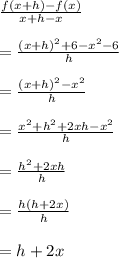
Mathematics, 26.08.2019 22:10 22ksotoq
The average rate of change of a function f(x)f from x=a to x=b is the slope of the line which passes through (a, f(a) and (b, f( consider the function f(x)=x^2+6 and find the following: (a) the average rate of change of f(x) from x=−1 to x=4. (b) the average rate of change of f(x) from x=a to x=b. (c) the average rate of change of f(x)f between the points (x, f(x)) and (x+h, f(x+ assume h> 0

Answers: 3
Another question on Mathematics

Mathematics, 20.06.2019 18:04
Working on itts i’m going to need you to me as i go along 1-5
Answers: 1

Mathematics, 21.06.2019 16:00
30 pts, will mark brainliestwhat is the period of the sinusoidal function? (picture 1)what is the minimum of the sinusoidal function? (picture2)what is the maximum of the sinusoidal function? (picture 3)
Answers: 3

Mathematics, 21.06.2019 16:10
On new year's day, the average temperature of a city is 5.7 degrees celsius. but for new year's day 2012, the temperature was 9.8 degrees below the average. i) if a represents the average temperature on new year's day and 7 represents the temperature on new year's day 2012, what formula accurately relates the two values together? ii) what was the temperature on new year's day 2012? dt a 0.8 ii) - 4 1 degrees celsius da-t-98 ii) 59 degrees celsius 1) 7 = -9,8 11) 59 degrees celsius ii) l degrees celsius
Answers: 2

Mathematics, 21.06.2019 23:10
What is the radius of the cone in the diagram? round your answer to the nearest whole number
Answers: 2
You know the right answer?
The average rate of change of a function f(x)f from x=a to x=b is the slope of the line which passes...
Questions

Health, 19.09.2019 09:00



Computers and Technology, 19.09.2019 09:00

Social Studies, 19.09.2019 09:00

Mathematics, 19.09.2019 09:00







Computers and Technology, 19.09.2019 09:00

Spanish, 19.09.2019 09:00

History, 19.09.2019 09:00


History, 19.09.2019 09:00



History, 19.09.2019 09:00



![\frac{f(4)-f(-1)}{4-(-1)}\\\\ =\frac{(4)^{2}+6-[(-1)^{2}+6]}{4+1}\\\\ =\frac{16+6-1-6}{5}\\\\ =\frac{15}{5}\\\\ =3](/tpl/images/0200/5248/d5343.png)




